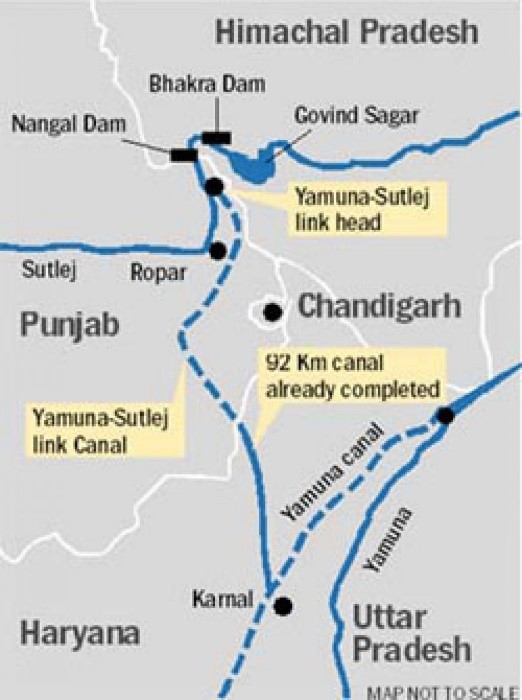- Indian-Built ARTIP Technology Revolutionizes Astronomy
- TRAI can’t regulate OTT platforms: TDSAT
- Money Bill
- Sutlej Yamuna Link (SYL) Canal
- Framework Convention for the Protection of National Minorities (FCNM)
- The State of the World’s Amphibians, 2023
Indian-Built ARTIP Technology Revolutionizes Astronomy
Context:
The National Investment and Infrastructure Fund (NIIF) of India, in collaboration with the Japan Bank for International Cooperation (JBIC), has jointly established a $600 million fund aimed at supporting climate and environmental projects.
India-Japan Fund
The Indian government will contribute 49% of the fund’s total capital, marking the NIIF’s inaugural bilateral fund, while JBIC will provide the remaining 51%, as stated by the finance ministry.
The primary objective of the India-Japan Fund is to invest in initiatives promoting environmental sustainability and low-carbon emission strategies, serving as a preferred partner for enhancing Japanese investments in India and fostering collaboration and innovation in this crucial sector.
Fund Management
The India-Japan fund will be managed by NIIF Limited, responsible for overseeing its strategic investments and initiatives.
JBIC IG, a subsidiary of JBIC, will work closely with NIIF Limited to promote Japanese investments in India, strengthening the partnership even further.
About NIIF
NIIF’s Background
Established in 2015, NIIF operates as a sovereign wealth fund, providing a platform for both international and Indian investors to participate in India’s growth story.
Ownership Structure
The government holds a 49% stake in NIIF, while the remaining 51% is owned by domestic institutional investors, sovereign wealth funds, international pension funds, and entities such as the US International Development Finance Corporation (USIDFC), as well as multilateral development banks including the Asian Infrastructure Investment Bank (AIIB), Asian Development Bank (ADB), and New Development Bank (NDB).
TRAI can’t regulate OTT platforms: TDSAT
Introduction
- The recent interim decision by the Telecom Disputes Settlement and Appellate Tribunal (TDSAT) has provided clarity regarding the jurisdiction of Over the Top (OTT) platforms like Hotstar.
- According to TDSAT, these platforms do not fall under the purview of the Telecom Regulatory Authority of India (TRAI) but are instead subject to the Information Technology Rules, 2021, administered by the Ministry of Electronics and Information Technology (MeitY).
Context for TDSAT’s Decision:
The initiation of the petition by the All India Digital Cable Federation (AIDCF), alleging discrimination by Star India in providing free streaming of ICC Cricket World Cup matches on mobile devices through Disney+ Hotstar, forms the backdrop for TDSAT’s decision.
This claim is rooted in TRAI regulations, as viewers can access matches exclusively on Star Sports TV channels through subscription and monthly payments.
Differing Perspectives on OTT Regulation:
- IT Ministry vs. DoT: The Ministry of Electronics and Information Technology (MeitY) argues that internet-based communication services, including OTT platforms, do not fall under the jurisdiction of the Department of Telecommunications (DoT), citing the Allocation of Business Rules.
- DoT’s Proposed Telecom Bill: In contrast, the Department of Telecommunications (DoT) has put forth a draft telecom Bill that categorizes OTT platforms as telecommunications services and seeks to regulate them as telecom operators. This proposal has met with objections from MeitY.
TRAI’s Efforts to Regulate OTT:
- TRAI’s stance on OTT regulation has evolved over time. After maintaining for three years that no specific regulatory framework was necessary for OTT communication services, TRAI initiated consultations on regulating these services.
- In June, TRAI released a consultation paper soliciting input on OTT service regulation and exploring the possibility of selectively banning OTT services as an alternative to complete Internet shutdowns.
Demand from Telecom Operators:
Telecom operators have consistently advocated for a “same service, same rules” approach and have pushed for regulatory intervention in the case of OTT platforms.
Significance of TDSAT’s Order:
The TDSAT’s recent decision holds considerable significance within the ongoing debates surrounding OTT service regulation.
TRAI and the Department of Telecommunications (DoT) have been actively working towards regulation, while the Ministry of Electronics and Information Technology (MeitY) opposes these efforts.
Recommendations and Oversight:
In September 2020, TRAI recommended against regulatory intervention for OTT platforms, suggesting that market forces should guide the sector.
However, it also emphasized the necessity for monitoring and intervention at an “appropriate time.”
Conclusion:
The TDSAT’s recent ruling on OTT platform jurisdiction adds complexity to the ongoing discourse regarding the regulation of these services in India.
While TRAI and the DoT pursue regulatory measures, the IT Ministry maintains that such services lie outside the scope of telecommunications regulation.
This evolving landscape underscores the need for a nuanced approach to balance the interests of various stakeholders, including telecom operators, government authorities, and the wider public.
Money Bill
Context:
In a recent legal development, the Supreme Court has taken a significant step by announcing its intent to form a seven-judge Bench to assess the validity of legislation categorized as Money Bills, including the Aadhaar Act. This move aims to address the ongoing controversies surrounding Money Bills in India’s legislative landscape.
Government’s Use of Money Bills under Scrutiny
- One of the key issues at hand is the government’s practice of introducing bills such as the Aadhaar Bill and amendments to the Prevention of Money Laundering Act as Money Bills.
- This strategy has been employed to bypass the Rajya Sabha, where the government lacked a majority, raising questions about its legitimacy.
Chief Justice D.Y. Chandrachud to Lead the Bench
- The newly constituted Bench will be led by Chief Justice D.Y. Chandrachud.
- As part of this process, it has been announced that all pending seven-judge Bench matters will be scheduled for procedural directions on October 12, adding a sense of urgency to this legal matter.
Legal Background: Referring the Finance Act, 2017
- This decision follows a significant legal precedent set in November 2019 when a five-judge Bench of the Supreme Court referred the issue of the Finance Act, 2017’s passage as a Money Bill to a larger Bench.
- This referral established a pivotal context for the current proceedings.
Understanding Money Bills
- To comprehend the significance of these legal proceedings, it’s essential to understand the criteria that classify a bill as a Money Bill.
- Money Bills address a range of matters, including taxation, government borrowing, funds such as the Consolidated Fund or Contingency Fund of India, appropriation of funds, declaration of expenditure, and related aspects.
Parliamentary Procedure for Money Bill Passage
- The passage of a Money Bill in Parliament involves a specific set of procedures.
- These bills can only be introduced in the Lok Sabha with the President’s recommendation and are treated as government bills, introduced solely by a minister.
- The Rajya Sabha can make recommendations but lacks the authority to amend or reject the bill.
- The Lok Sabha can either accept or reject any recommendations made by the Rajya Sabha.
- If accepted, the bill proceeds in its modified form; if not, it passes in its original form.
- Importantly, the President may give or withhold assent to a Money Bill but cannot return it for reconsideration.
Challenges and Concerns Surrounding Money Bills
Over time, concerns and challenges have arisen concerning the use of Money Bills in India’s legislative process:
- Misuse to Bypass Legislative Scrutiny: Money Bills have been at the center of controversies involving attempts to bypass thorough legislative scrutiny.
- Controversies Over Qualification: Disputes have emerged regarding whether certain bills legitimately qualify as Money Bills.
- Speaker’s Role in Certifying Bills: Questions have been raised about the Speaker’s role in certifying bills as Money Bills, adding complexity to the issue.
- Inclusion of Non-Financial Provisions: Instances have been noted where non-financial provisions were included in Money Bills, sparking further debates.
This legal development sheds light on the ongoing debate and legal examination surrounding the use of Money Bills in India’s legislative landscape
Sutlej Yamuna Link (SYL) Canal
Context:
The Supreme Court’s directive mandates the Punjab government to complete the construction of the SYL project.
Introduction to the Sutlej Yamuna Link (SYL) Canal:
- The Sutlej Yamuna Link (SYL) Canal, spanning approximately 121 kilometers in Punjab and 90 kilometers in Haryana, has a primary objective of allocating 3.45 million acre-feet (MAF) from Haryana’s total annual share of surplus Ravi-Beas waters, which stands at 3.5 MAF according to the 1981 agreement.
- This canal system is designed to facilitate irrigation across 4.46 lakh hectares of land in Haryana and also extend benefits to Punjab by providing irrigation for 1.28 lakh hectares.
- Furthermore, it contributes to power generation with a total capacity of 50 megawatts through two powerhouses.
Historical Background of the SYL Canal Dispute:
- The origins of the SYL Canal dispute trace back to 1966 during the reorganization of Punjab and the formation of Haryana.
- At that time, Punjab opposed sharing the waters of these two rivers with Haryana, invoking riparian principles.
- In 2020, the Supreme Court directed the Central Government to mediate between the Chief Ministers of Punjab and Haryana in an effort to find an amicable resolution to the SYL Canal dispute.
- However, as of 2023, the Central Government informed the Supreme Court that these talks had failed due to Punjab’s refusal to fulfill its obligations regarding the canal’s construction.
Insights into the Satluj River:
- The Satluj River originates in the ‘Rakshas tal’ near Mansarovar at an elevation of 4,555 meters in Tibet, where it is known as Langchen Khambab.
- It flows nearly parallel to the Indus for approximately 400 kilometers before entering India and emerging from a gorge at Rupar.
- Subsequently, it traverses the Shipki La in the Himalayan ranges and enters the plains of Punjab.
- The Satluj River is significant as it serves as a vital tributary, providing water to the canal system of the Bhakra Nangal project.
Overview of the Ravi River:
- The Ravi River, another essential tributary of the Indus, originates west of the Rohtang pass in the Kullu hills of Himachal Pradesh.
- It courses through the Chamba valley of the state before entering Pakistan and eventually joining the Chenab near Sarai Sidhu.
- Along the way, it drains the region situated between the southeastern part of the Pir Panjal and the Dhauladhar ranges.
Insight into the Beas River:
The Beas River, yet another significant tributary of the Indus, originates from the Beas Kund near the Rohtang Pass at an elevation of 4,000 meters above sea level.
It flows through the Kullu valley, forming gorges at Kati and Largi in the Dhauladhar range, before entering the plains of Punjab. There, it meets the Satluj River near Harike.
Understanding the Yamuna River:
- The Yamuna River, the westernmost and longest tributary of the Ganga, originates from the Yamunotri glacier on the western slopes of the Bandarpunch range.
- It joins the Ganga at Prayag (Allahabad) and receives contributions from various other rivers, including the Chambal, Sind, Betwa, Ken (from the Peninsular plateau), Hindan, Rind, Sengar, and Varuna.
The Yamuna’s waters are crucial for supporting the western and eastern Yamuna and the Agra canals, primarily for irrigation purposes.
Framework Convention for the Protection of National Minorities (FCNM)
Context:
In recent news, President Vladimir Putin has put forward a bill to approve Russia’s withdrawal from the Framework Convention for the Protection of National Minorities (FCNM).
FCNM: A Landmark Treaty for Minority Rights
- FCNM stands as the most comprehensive legally binding treaty globally, dedicated to safeguarding the rights of minority groups.
- Originally adopted by the Council of Europe in 1994, Russia ratified it when it became a member of the multinational body in February 1996.
- This convention outlines specific principles that signatory nations are expected to adhere to when formulating their national policies regarding various minority groups, including indigenous populations, stateless minorities, and those with national autonomy.
- FCNM is highly regarded by human rights experts for addressing a wide range of issues related to minority rights, such as the use of minority languages in media and education, and the preservation and safeguarding of minority cultures, histories, languages, and religions.
The Council of Europe: A Key Player in Human Rights
- The Council of Europe, established in 1949, is an international organization based in Strasbourg.
- It’s important to note that this organization is separate from the European Union (EU).
- All member states of the Council of Europe have signed the European Convention on Human Rights, a treaty designed to uphold human rights, democracy, and the rule of law.
Implications for Russia’s Minority Groups
So, what are the implications of Russia’s decision for its minority groups?
- Russia is home to an astonishingly diverse array of ethnicities, with as many as 193 distinct ethnic groups speaking at least 270 different languages and dialects.
- However, Russia’s historical policies and actions towards these minority groups have often contradicted some of the fundamental principles outlined in the Framework Convention.
- These discriminatory policies include repressive actions against ethnic and decolonial activists, restrictions on the teaching and public use of minority languages, and the forced assimilation and discrimination of ethnic Ukrainians in Russia and the occupied Ukrainian territories.
Isolation on the International Stage
- The withdrawal from the FCNM can be seen as another step towards Russia’s increased international isolation.
This development is disconcerting because it means that human rights advocates will no longer have the opportunity to voice their concerns in Strasbourg or seek consultation with the Council of Europe on critical issues.
The State of the World’s Amphibians, 2023
Context:
In accordance with the findings of the second global amphibian assessment (GAA2), a recent research study has pinpointed climate change as the foremost threat to the existence of amphibians.
- Published on October 4 in the journal Nature, the study, titled ‘Ongoing declines for the world’s amphibians in the face of emerging threats,’ conducted an analysis of global data spanning two decades.
- It involved the collaboration of more than 1,000 experts and an evaluation of over 8,000 amphibian species, including 2,286 that were assessed for the first time.
- Startlingly, the data disclosed that 40% of amphibian species are now facing the risk of extinction, and these findings are set to be incorporated into the IUCN Red List of Threatened Species.
- Between the years 2004 and 2022, over 300 amphibian species moved perilously closer to extinction, with climate change identified as the primary threat for 39% of them.
- The Global Amphibian Assessment (GAA), instigated by the Amphibian Red List Authority in 2015, serves the purpose of evaluating all amphibian species for inclusion in the IUCN Red List of Threatened Species.
Key Findings from the Study:
- During the period from 2004 to 2022, more than 300 amphibian species edged closer to the brink of extinction.
- Disturbingly, 2 out of every 5 amphibian species now face the threat of extinction.
- Salamanders are the most vulnerable group, with 3 out of 5 species at risk.
- On a global scale, 41% of amphibian species are currently endangered.
- The primary threats include habitat loss, climate change, disease, wildfires, invasive species, and over-exploitation.
- The Neotropical realm is identified as the most threatened biogeographic region.
- Amphibians encounter difficulties in escaping extreme weather events induced by climate change, largely due to their limited mobility.
- There are signs of recovery in certain areas, especially when critical habitats are protected.
A Brief Overview of Amphibians:
- Amphibians, classified as vertebrates within the Amphibia class, are characterized by having four limbs and an ectothermic metabolism.
- All existing amphibians are categorized under the group Lissamphibia. They inhabit a wide range of ecosystems, including terrestrial, fossorial, arboreal, and freshwater aquatic environments.
- Typically, amphibians commence their life cycle as aquatic larvae, although some species have evolved to bypass this stage. Young amphibians undergo metamorphosis, transitioning from larval forms with gills to adult forms with lungs.
- Their skin serves as a secondary respiratory surface, and certain small salamanders and frogs lack lungs entirely, relying solely on their skin for respiration.
- In contrast to reptiles, amphibians necessitate water bodies for breeding due to their intricate reproductive requirements and permeable skin.
- Amphibians frequently serve as ecological indicators, and there has been a noticeable decline in amphibian populations worldwide in recent decades.
- The earliest amphibians originated during the Devonian period, evolving from sarcopterygian fish and eventually adapting to terrestrial life.
- They flourished during the Carboniferous and Permian periods but were subsequently overshadowed by reptiles and other vertebrates.
- Modern amphibians, belonging to the Lissamphibia group, likely emerged from temnospondyls during the Permian period, approximately 250 million years ago.
- There exist three primary orders of amphibians: Anura (frogs), Urodela (salamanders), and Apoda (caecilians). Approximately 8,000 amphibian species are documented, with nearly 90% of them being frogs.
- The smallest known amphibian and vertebrate are the New Guinea frogs (Paedophryne amauensis), measuring a mere 7.7 mm (0.30 in) in length. On the other end of the scale, the largest living amphibian is the South China giant salamander (Andrias sligoi), measuring 1.8 m (5 ft 11 in) in length. However, prehistoric temnospondyls like Mastodonsaurus could attain lengths of up to 6 m (20 ft).
The scientific study of amphibians is termed batrachology, while the study of both reptiles and amphibians is referred to as herpetology.







